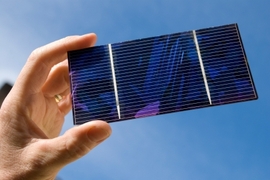 |
Date Announced: 13 Oct 2010
Constant seek for lower production costs and improved efficiency of solar cells leads to a massive adoption of laser processes. Laser-based tools offer contactless processing in micrometer scale, by selective removal or modification of respective layer in a cSi wafer.
It is possible to get closer to the theoretical limit of efficiency of solar cell only by forming extremely precise layers (chemical processes) and performing high fidelity structuring and contact formation (laser processes). These goals can be achieved if wavelength of laser radiation conforms to the absorption band of the layer that is being processed. High performance stability, high frequency and sufficient average power are the prerequisites to reach the required level of energy density for a specific process, whereas pulse duration determines quality of processing - the shorter pulse duration, the higher accuracy of processing can be achieved. Femtosecond (<300 fs) pulses decrease probability of micro cracks and minimize outspread of heat affected zone, thus leading to advantages described below.
‘Laser islands’ standing in line with chemical baths today are mostly equipped with nanosecond lasers as a solution, which is cost effective but rather hindering some attractive applications like Emitter Contact Formation, Laser Doping, etc. As the new laser technologies become more powerful and affordable in terms of cost of ownership, nanosecond devices will be changed by more effective pico- and femto-second laser based tools that already make their way from labs to industry.
In 2009 the photovoltaic pilot line (industrial laboratory) of up to 2 MW was launched in Lithuania. Lithuanian laser technology company Altechna designed and manufactured laser based tool called ALTSE-001 performing four technological operations:
* laser marking
* edge isolation
* back contact laser firing
* dielectric layer ablation for front contact formation
ALTSE -001 is a flexible industrial research workstation, which is equipped with nanosecond and femtosecond lasers and has features like automated wafer handling and machine vision for wafer position detection.
System has two processing zones. In the first one three operations are being done: marking, edge isolation and back contact firing. These operations are executed with the nanosecond fiber laser, that has repetition rate up to 500 kHz, average power up to 20 W, wavelength 1064 nm.
Much higher precision is required for operation of second processing zone. Selective removal of dielectric layer (SiNx) on the emitter side of the wafers is being done with femtosecond pulses. Ablation is performed using 343 nm wavelength laser radiation with pulse repetition rate up to 100 kHz, average power up to 1,4 W. SiNx layer that is 50-90 nm thick, must be precisely removed by opening emitter without damage to it. While ablation of the dielectric layer, openings for bus bars and fingers are being created. On the next step ablated openings of the wafers are covered by nickel. Later on the nickel layer copper is being deposited. In this way high quality front contacts are formed and more expensive silver is substituted by copper.
18% efficiency of the cells is expected to be evident by the end of year 2010.
From now on Altechna represents its R&D activities under a new brand name - Workshop of Photonics. Workshop here bears two meanings: it is a place where photonic equipment is made and at the same time, in our laboratories, exchange of experience occurs between researchers from different countries, this reflects the spirit of open innovations.
Source: Altechna
E-mail: ruta.balciunaite@altechna.com
Web Site: www.wophotonics.com
| © 2024 SPIE Europe |
|